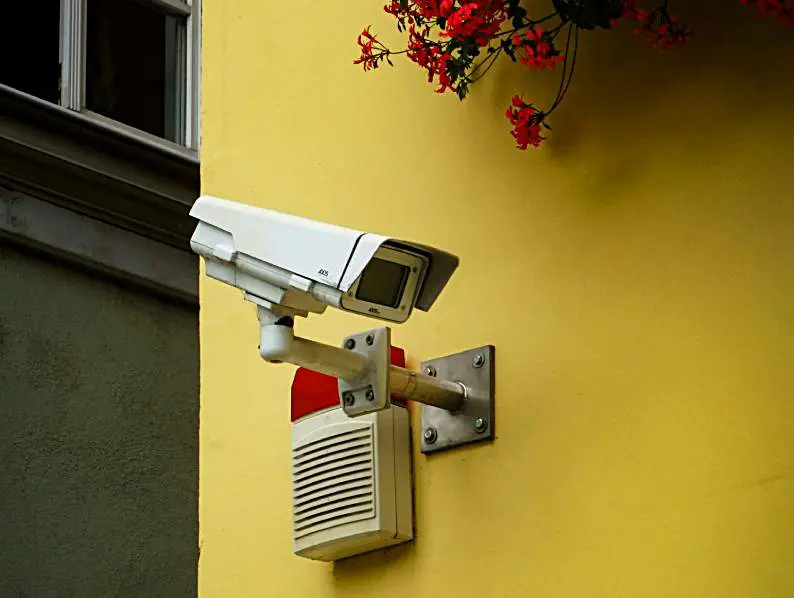words Al Woods
Home security systems have become an essential part of modern living, offering peace of mind and protection for families and their belongings. With a variety of options available, choosing the right system can be overwhelming. This guide aims to simplify the process, providing you with all the information needed to make an informed decision.
Understanding Home Security Systems
Home security systems are designed to protect your home from intruders, fire, and other emergencies. They typically include a combination of devices such as alarms, cameras, sensors, and control panels. These components work together to detect and respond to potential threats.
The primary function of a home security system is to deter criminals. Visible cameras and alarm systems can discourage would-be intruders from targeting your home. In the event of a break-in, the system can alert you and the authorities, increasing the chances of catching the perpetrator.
Modern systems also offer additional features such as fire detection, carbon monoxide monitoring, and even flood sensors. These added layers of protection ensure that your home is safeguarded against a wide range of hazards.
Types of Home Security Systems
There are several types of home security systems available, each with its own set of features and benefits. Understanding the differences can help you choose the best system for your needs.
Monitored Systems
Monitored systems are connected to a central monitoring station that oversees your home 24/7. If an alarm is triggered, the monitoring station will contact you and, if necessary, dispatch emergency services. This type of system offers the highest level of security but usually comes with a monthly fee.
Unmonitored Systems
Unmonitored systems rely on loud alarms and flashing lights to scare off intruders and alert neighbours. While they don’t offer the same level of protection as monitored systems, they are more affordable and can still be effective in deterring criminals.
Wireless Systems
Wireless systems use radio signals to communicate between devices, making them easy to install and expand. They are ideal for renters or those who don’t want to drill holes in their walls. However, they can be susceptible to interference from other electronic devices.
Wired Systems
Wired systems are hardwired into your home’s electrical system, providing a reliable and stable connection. They are less prone to interference but can be more challenging to install, often requiring professional assistance.
Key Components of a Home Security System
A comprehensive home security system includes several key components, each playing a crucial role in protecting your home.
Control Panel
The control panel is the heart of your security system, allowing you to arm and disarm the system, monitor sensors, and communicate with the monitoring station. Modern control panels often feature touchscreens and can be controlled remotely via smartphone apps.
Sensors
Sensors are placed around your home to detect movement, open doors and windows, and monitor environmental conditions. Common types of sensors include motion detectors, door/window sensors, glass break detectors, and smoke/CO2 detectors.
Cameras
Security cameras provide visual surveillance of your property, allowing you to monitor activity in real-time or review recorded footage. Cameras can be placed indoors or outdoors and may include features such as night vision, motion detection, and two-way audio.
Alarms
Alarms are designed to alert you and others to potential threats. They can be loud sirens, flashing lights, or silent alarms that notify the monitoring station. The type of alarm you choose will depend on your specific needs and preferences.
Additional Features
Many modern security systems offer additional features such as smart home integration, remote access, and automation. These features can enhance the functionality of your system and provide added convenience.
Choosing the Right Home Security System
Selecting the right home security system involves considering several factors, including your budget, the size of your home, and your specific security needs.
Assess Your Needs
Start by assessing your security needs. Consider the size of your home, the number of entry points, and any specific vulnerabilities. For example, if you live in a high-crime area, you may want a more robust system with professional monitoring.
Set a Budget
Determine how much you are willing to spend on a security system. Keep in mind that while unmonitored systems are more affordable upfront, monitored systems offer greater protection and peace of mind. Factor in any monthly fees for monitoring services.
Research Providers
Research different security system providers to find one that offers the features you need at a price you can afford. Look for reputable companies with positive customer reviews and reliable customer support.
Consider Installation
Decide whether you want to install the system yourself or hire a professional home security company. DIY systems are typically easier to install and can save you money, but professional installation ensures that everything is set up correctly and functioning properly.
Test the System
Once your system is installed, test it thoroughly to ensure that all components are working correctly. Regular testing and maintenance are essential to keep your system in top condition.
Benefits of Home Security Systems
Investing in a home security system offers numerous benefits beyond just protecting your home from intruders.
Peace of Mind
Knowing that your home is protected gives you peace of mind, whether you’re at home or away. You can rest easy knowing that your family and belongings are safe.
Deterrence
Visible security systems can deter criminals from targeting your home. The presence of cameras and alarms makes your property less attractive to would-be intruders.
Emergency Response
In the event of an emergency, a monitored security system can quickly alert authorities, ensuring a rapid response. This can be crucial in situations such as fires or medical emergencies.
Insurance Discounts
Many insurance companies offer discounts on home insurance premiums for homes with security systems. This can help offset the cost of the system and provide additional savings.
Remote Access
Modern security systems often include remote access features, allowing you to monitor and control your system from anywhere using a smartphone or computer. This added convenience ensures that you can keep an eye on your home even when you’re not there.
Common Mistakes to Avoid
When setting up a home security system, it’s important to avoid common mistakes that can compromise your safety.
Overlooking Entry Points
Ensure that all entry points, including doors, windows, and garage doors, are secured with sensors and cameras. Overlooking these areas can leave your home vulnerable to intruders.
Ignoring Maintenance
Regular maintenance is essential to keep your security system functioning properly. Test your system regularly and replace batteries in sensors and alarms as needed.
Choosing the Wrong System
Selecting a system that doesn’t meet your needs can leave you feeling unprotected. Take the time to assess your security requirements and choose a system that offers the features you need.
Skimping on Professional Monitoring
While unmonitored systems are more affordable, they don’t offer the same level of protection as monitored systems. Investing in professional monitoring can provide added peace of mind and ensure a rapid response in an emergency.
Failing to Use the System
A security system is only effective if it’s used correctly. Make sure that all family members know how to arm and disarm the system and understand the importance of using it consistently.
Future Trends in Home Security
The home security industry is constantly evolving, with new technologies and trends emerging to enhance protection and convenience.
Smart Home Integration
Integration with smart home devices is becoming increasingly popular, allowing homeowners to control their security systems alongside other smart devices such as lights, thermostats, and locks.
Artificial Intelligence
Artificial intelligence (AI) is being used to improve the accuracy and efficiency of security systems. AI-powered cameras can recognise faces, detect unusual activity, and even differentiate between humans and animals.
Cloud Storage
Cloud storage offers a convenient and secure way to store video footage from security cameras. This allows homeowners to access recordings from anywhere and ensures that footage is safe from tampering or damage.
Enhanced Connectivity
Improved connectivity options, such as 5G and Wi-Fi 6, are enabling faster and more reliable communication between security devices. This ensures that alerts and notifications are delivered promptly.
Environmental Monitoring
In addition to traditional security features, modern systems are incorporating environmental monitoring for hazards such as fire, carbon monoxide, and flooding. This provides comprehensive protection for your home and family.
Conclusion
Choosing the right home security system is a crucial decision that can significantly impact your safety and peace of mind. By understanding the different types of systems, key components, and factors to consider, you can make an informed choice that meets your needs and budget.
Investing in a home security system not only protects your home from intruders but also offers additional benefits such as emergency response, insurance discounts, and remote access. Avoid common mistakes and stay informed about future trends to ensure that your home remains secure for years to come.
Remember, the best security system is one that you feel confident using and that provides the level of protection you need. Take the time to research and choose a system that fits your lifestyle and offers the features that matter most to you.





